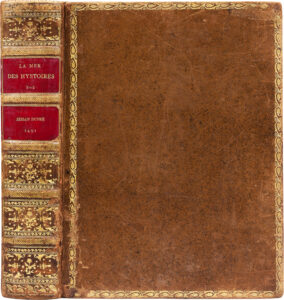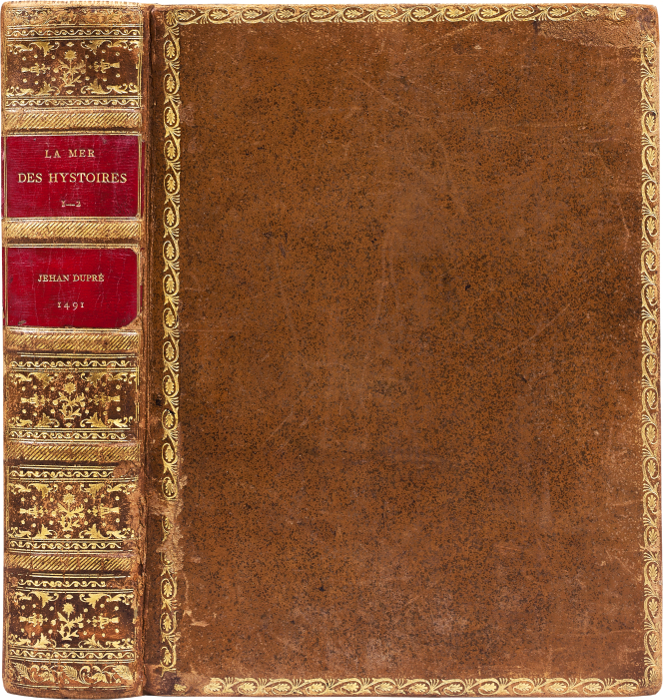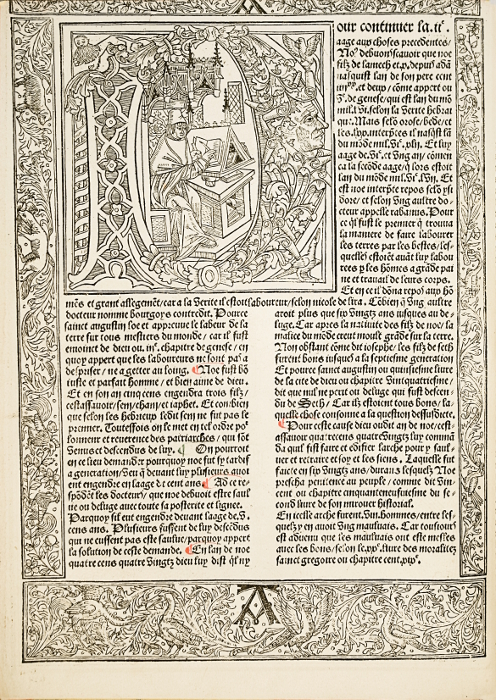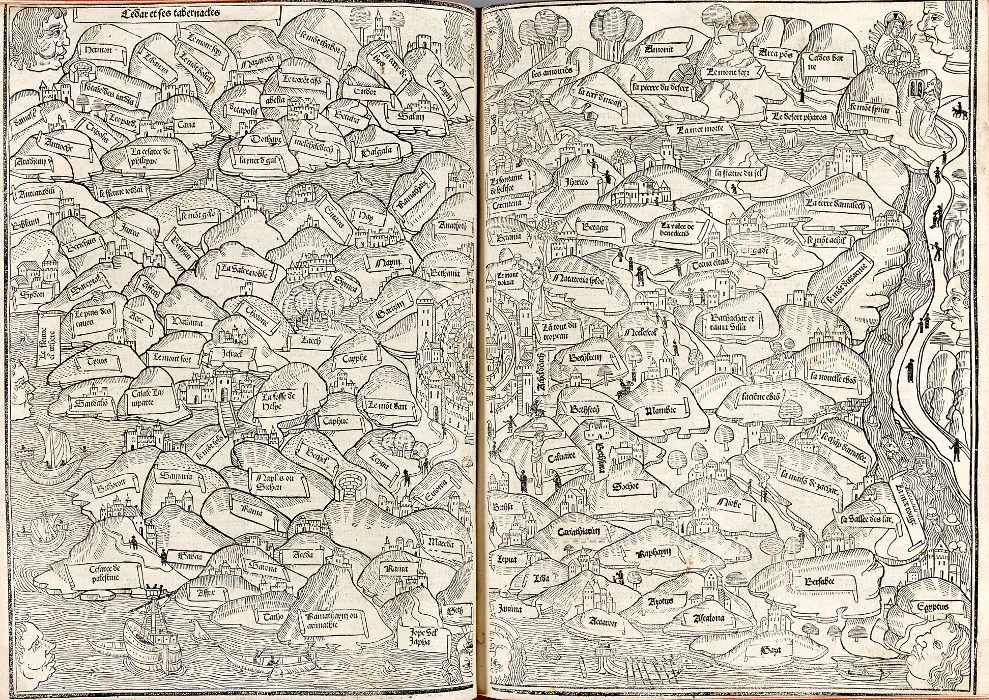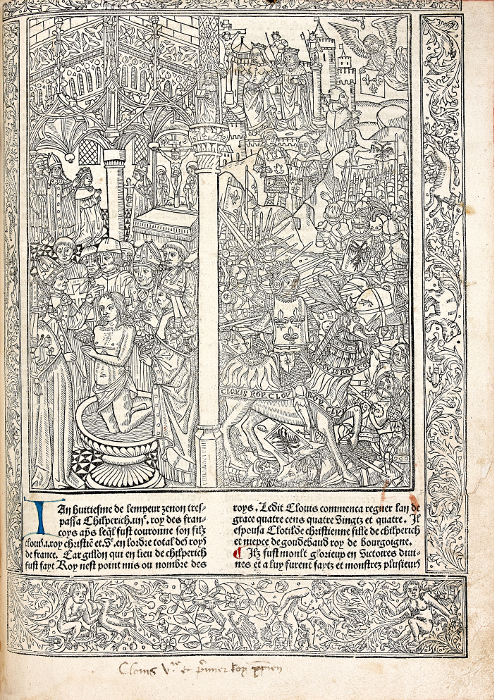Lyon, Jean Dupré ; imprint August 20th 1491 for the first volume; August 23rd 1491 for the second volume.
Two parts bound in 1 large folio volume [311 x 237 mm]. Part 1: 214 ll. a10, a-z8, aa8, bb6, cc6; Part 2: 253 ll. A-V, AA-GG8, HH6 II-LL8 óó8 ; which is a total of 467 leaves; missing 7 ll. like most of the extremely rare listed copies: a1 (title of the first volume), 3 ll. of text (d4, d5 and DD1) and the last 3 ll. of table, l. f1 torn; short top margin. Full light brown granite-like calf, gilt borders on the covers, spine ribbed richly decorated, red morocco lettering pieces, red edges. Binding of the end of the 18th century.
First and famous incunable edition from Lyons of « La Mer des Hystoires », one of the most beautiful and ambitious historical and literary incunabula in French language, imprint on August 23rd 1491 by the first French printer having practiced in the capital of Gaul, and the second edition of this text published after the one given by Pierre Le Rouge in Paris in 1488.
“These two incunable first editions are among the most beautiful of the history of French printing with the ones given by Guy Marchant or Antoine Verard”.
“La Mer des Hystoires” is an original adaptation in French language of a Latin text describing the universal history of France from its origins until the death of King Louis XI.
“It is completed with a geographical dictionary, a description of the Holy Land, Aesop’s Fables and a genealogy of kings of France until the death of King Louis I and followed by a second part entitled Le Martirologe des sainctz. The illustration includes large historiated capital letters, includng a spectacular calligraphed-style L, large initial woodcut decorated with interlacings and adorned with characters, animals and grotesques, for the title pages. Among the large plates created especially for these incunable editions there are the Clovis’s famous baptism next to the battle of Tolbiac and genealogic suites. There are also pictures presenting everyday life scenes or episodes of the Virgin’s life, lengthwise engravings (crossing of the Red Sea), small figures specific to book of hours (Annunciation, Visitation, Nativity…), large initials with fleurons for the beginning of chapters and borders with foliated scroll, birds, and fantastical animals. Most of the woodcuts were then handed to the funds of Antoine Vérard’s collection.” (N. Petit, Les Incunables : livres imprimés au XVe siècle).
Claudin (Histoire de l’Imprimerie française) dedicated 23 full pages to the description and the reproduction of the woodcuts of the first two incunable editions: “In July 1487 was published the first volume of the ‘La Mer des Histoires’, illustrated book of majestic look, entirely filled with large and small woodcuts, with artistically drawn borders, ornaments with a very original conception and initials reminding both the vagaries of the calligraphers quill and the fantasies of the illuminator’s brush. Seven months after was published the second volume, brilliant of French art.”
The world and Palestine maps are the first to appear in a French printed book. It is in this precious work that are also the so famous woodcuts representing “Clovis’s baptism” and the “Battle of Tolbiac”, considered as “one of the most precious productions of woodcuts of the 15th century”. G. Duplessis.
The originality and the profusion of this decoration reveal the engraver’s desire to carry on the luxuriousness of the illuminator’s brush decoration in the printed book. It arouses the praising admiration of Claudin: “Everybody agrees upon the artistic merit of ‘La Mer des Hystoires’ which is known to be the most beautiful French illustrated book of the 15th century. It is a genuine master-piece. The miniaturist’s art went all of a sudden in the printed book domain.”
This first edition from Lyons printed by Jean du Pré in 1491 is illustrated with 256 woodcuts, repeated several times, of which 54 are in full page, 6 with a full page border, and 196 of smaller dimensions.
The copy is enriched with handwritten notes of the 15th and 16th century of which a poem by the famous Jacques Gohorry (1520-1576): La puissance damour (fini par : Ainsi tu peux enflammer, // Amour, de tes étincelles, // Le ciel, l’enfer et la mer, // Et les choses plus rebelles. Donc, à bon droit, nous humains, Adorerons ta puissance, Vu que les dieux souverains Te rendent obéissance) // et une recette manuscrite pour le traitement de la gravelle : « Pour faire vuyder la gravelle sans faire aucun grief au corps : Prenez racine de percil, racine de fenoil et racine d’ache assez largement… et puis mectez toutes lesdites racines bouillir en ung grant pot avecques eau de fontaine… y meptre du miel purifié sur le feu… et puys passer leau par ung linge neuf et la boire au matin… Et si la gravelle estoit trop forte et ne vuydast il faut droyt y meptre bouillir avecques lesdites herbes du saxifrage ». XVIe siècle.
Provenance: Jehan Daverton (Jean d’Averton equerry, sir of Belin and Averton near Laval, married to Marguerite de Laval (f. HH5v0) 15-16th century ; Ambroys Ledru (f. a10v0), 16th century; “Ex-libris Rivault” (on the last leaf) 17-18th century; Ex-libris Paul Harth (20th century).
This incunable edition from Lyons of “La Mer des Hystoires” one of the most beautiful works from the European presses of the 15th century, is rarer than the two other incunable editions of the same text from Pierre le Rouge’s presses in 1488 and Antoin verard’s in 1500. No complete copy of this first 1491 edition from Lyons has been recorded on the public market for a century.
